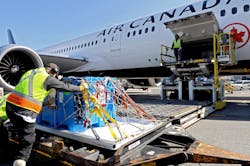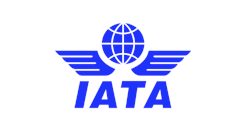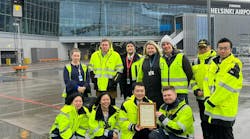Animals have been transported by air since the early-1930s and in today’s modern world, officials at the International Air Transport Association (IATA) say moving animals by air is considered the most humane and expedient method of transportation over long distances.
In recent decades, the frequency of animals transported by aircraft has been increasing. Sonia Ben Hamida, head of special cargo at IATA, says the increase is in part due to globalization, the increased mobility of people and global conservation efforts.
“When it comes to transporting animals, it is not just about moving them from A to B,” Ben Hamida says. “It is about recreating their natural environment, ensuring their physiological and psychological well-being, and making sure they arrive at their destination in the best possible condition. It is a major responsibility, involving science, logistics and compassion."
Further, she says the transport of endangered species often stands for an even larger mission – the survival of their species or the restoration of a natural habitat.
Because ground handlers play a key role in the complex process of live animal transportation, Ben Hamida encourages regular training to keep updated with the latest IATA regulations and best practices. IATA member airlines commit to comply with IATA’s Live Animals Regulations (LAR). What’s more, the IATA Center of Excellence for Independent Validators (CEIV) for Live Animals Logistics certification, open to all, ensures that organizations meet the standards set by the LAR.
The 2024 Edition of IATA’s Live Animals Regulations marks an important milestone for IATA and the aviation industry.
“It signifies 50 years of dedicated effort to ensure that live animals, when transported by air, are handled and carried in a manner which accounts for their welfare, safety and comfort,” Ben Hamida says.
During this time, she says there has been a significant shift towards prioritizing animal welfare.
“Recent editions have incorporated extensive research on animal behavior and physiology to ensure their well-being during transport,” she says.
As IATA’s understanding of different animal species has grown, including learning behaviors, stressors and comfort needs, regulations have become more detailed. Today, for example, there are 61 container requirements for different types of animals.
Some animals can travel in the cabin, some cannot.
Recently, the number of passengers traveling with emotional support animals (ESAs) has increased. Note emotional support animals are not the same as service animals.
“Service animals are trained to perform tasks and have specific rights under federal laws in many countries,” Ben Hamida says. “While emotional support animals are not necessarily trained and offer comfort and support to their owners. Their status can differ significantly.”
Individual airlines determine the specifications and conditions to handle ESAs. That includes the types of ESAs they allow, how ESAs are accommodated in the cabin and whether additional documentation or verification is required. Containers must comply with the LAR container requirements. That means containers must be secure, well-ventilated and comfortable for the animal.
Ground handlers must know which animals are accepted in-cabin; what documentation is required; and how animals should be accommodated.
To increase awareness of the responsibilities and requirements of in-cabin animal transport, IATA developed an in-cabin live animal checklist, and after a year-long transition, the checklist in 2023 became a mandatory LAR requirement. According to Ben Hamida, the result has been more consistent practices and enhanced awareness.
She says, here, the emphasis for ground handlers is to ensure that personnel are trained on the checklist's specifics and understand its significance; to communicate proactively with passengers to avoid any last-minute confusion or non-compliance; and to provide their feedback on the checklist's effectiveness, any challenges faced or areas of potential improvement to IATA.
The 2024 LAR edition features significant changes, including updates to documentation, container requirements and marking.
For documentation, the IATA live animal acceptance checklist for cargo is distinguished from the in-cabin checklist. The checklist specifies marking containers carrying animals that can inflict poisonous or venomous bites or stings. Also, information pertaining to the use of sedatives or tranquilizers is required.
For container requirements, stocking density guidelines have been revised for pigs and Container Requirement 3 has multiple amendments from accepted construction materials to precise instructions for bulk transport and loading density for horses.
Ben Hamida says there has been a more concerted effort to involve various stakeholders in the LAR's development including veterinarians, animal welfare organizations and zoological experts.
“Their insights and real-world experiences have played a crucial role in shaping a more holistic and informed approach to animal transport,” she says.
Training and certifying personnel involved in the transportation of live animals has increasingly been emphasized.
“This ensures that everyone involved understands and adheres to the highest standards of care,” Ben Hamida says.
IATA’s CEIV for Live Animals Logistics certification process requires training, an assessment and validation.
“Entities wishing to obtain this certification must undergo a rigorous evaluation process,” Ben Hamida says, noting this certification is open to all, and not exclusive to IATA members. “Once certified, they showcase a commitment to excellence in live animal transportation and animal welfare. It reflects the collective commitment of the aviation industry to treat animals with the respect and care.”
In the beginning of September, Ben Hamida reported there were 29 organizations with this certification including seven airlines, 10 cargo handling facilities, four ramp handlers and eight freight forwarders.
“Training is essential and remains at the core of ensuring the welfare of animals,” Ben Hamida concludes. “It is important that ground handling personnel undergo regular training to remain updated with the latest IATA regulations and best practices.
“The safety of animals must never be compromised. Procedures are in place to avoid distress or harm to the animals.
“As discussed, the illegal wildlife trade poses a significant challenge. Ground handlers, being on the front lines, should be vigilant and proactive in identifying and reporting any suspicious shipments.
“The role of ground handlers is pivotal in shaping the experience of live animals during air transport by being skilled and proactive.”





